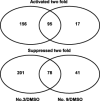Small-molecule inhibitors suppress the expression of both type III secretion and amylovoran biosynthesis genes in Erwinia amylovora
- PMID: 23915008
- PMCID: PMC6638656
- DOI: 10.1111/mpp.12064
Small-molecule inhibitors suppress the expression of both type III secretion and amylovoran biosynthesis genes in Erwinia amylovora
Abstract
The type III secretion system (T3SS) and exopolysaccharide (EPS) amylovoran are two essential pathogenicity factors in Erwinia amylovora, the causal agent of the serious bacterial disease fire blight. In this study, small molecules that inhibit T3SS gene expression in E. amylovora under hrp (hypersensitive response and pathogenicity)-inducing conditions were identified and characterized using green fluorescent protein (GFP) as a reporter. These compounds belong to salicylidene acylhydrazides and also inhibit amylovoran production. Microarray analysis of E. amylovora treated with compounds 3 and 9 identified a total of 588 significantly differentially expressed genes. Among them, 95 and 78 genes were activated and suppressed by both compounds, respectively, when compared with the dimethylsulphoxide (DMSO) control. The expression of the majority of T3SS genes in E. amylovora, including hrpL and the avrRpt2 effector gene, was suppressed by both compounds. Compound 3 also suppressed the expression of amylovoran precursor and biosynthesis genes. However, both compounds induced significantly the expression of glycogen biosynthesis genes and siderophore biosynthesis, regulatory and transport genes. Furthermore, many membrane, lipoprotein and exported protein-encoding genes were also activated by both compounds. Similar expression patterns were observed for compounds 1, 2 and 4. Using crab apple flower as a model, compound 3 was capable of reducing disease development in pistils. These results suggest a common inhibition mechanism shared by salicylidene acylhydrazides and indicate that small-molecule inhibitors that disable T3SS function could be explored to control fire blight disease.
© 2013 BSPP AND JOHN WILEY & SONS LTD.
Figures






Similar articles
-
Genetic characterization of the HrpL regulon of the fire blight pathogen Erwinia amylovora reveals novel virulence factors.Mol Plant Pathol. 2012 Feb;13(2):160-73. doi: 10.1111/j.1364-3703.2011.00738.x. Epub 2011 Aug 10. Mol Plant Pathol. 2012. PMID: 21831138 Free PMC article.
-
Virulence Genetics of an Erwinia amylovora Putative Polysaccharide Transporter Family Member.J Bacteriol. 2020 Oct 22;202(22):e00390-20. doi: 10.1128/JB.00390-20. Print 2020 Oct 22. J Bacteriol. 2020. PMID: 32839177 Free PMC article.
-
Genome-wide identification of genes regulated by the Rcs phosphorelay system in Erwinia amylovora.Mol Plant Microbe Interact. 2012 Jan;25(1):6-17. doi: 10.1094/MPMI-08-11-0207. Mol Plant Microbe Interact. 2012. PMID: 21936662
-
Virulence Factors of Erwinia amylovora: A Review.Int J Mol Sci. 2015 Jun 5;16(6):12836-54. doi: 10.3390/ijms160612836. Int J Mol Sci. 2015. PMID: 26057748 Free PMC article. Review.
-
Molecular genetics of Erwinia amylovora involved in the development of fire blight.FEMS Microbiol Lett. 2005 Dec 15;253(2):185-92. doi: 10.1016/j.femsle.2005.09.051. Epub 2005 Oct 13. FEMS Microbiol Lett. 2005. PMID: 16253442 Review.
Cited by
-
Xylella fastidiosa subsp. pauca Strains Fb7 and 9a5c from Citrus Display Differential Behavior, Secretome, and Plant Virulence.Int J Mol Sci. 2020 Sep 15;21(18):6769. doi: 10.3390/ijms21186769. Int J Mol Sci. 2020. PMID: 32942709 Free PMC article.
-
Bacterial disease management: challenges, experience, innovation and future prospects: Challenges in Bacterial Molecular Plant Pathology.Mol Plant Pathol. 2016 Dec;17(9):1506-1518. doi: 10.1111/mpp.12436. Epub 2016 Aug 8. Mol Plant Pathol. 2016. PMID: 27238249 Free PMC article. Review.
-
Identification of phenolic compounds that suppress the virulence of Xanthomonas oryzae on rice via the type III secretion system.Mol Plant Pathol. 2017 May;18(4):555-568. doi: 10.1111/mpp.12415. Epub 2016 Jul 1. Mol Plant Pathol. 2017. PMID: 27084974 Free PMC article.
-
Mutation of the Erwinia amylovora argD gene causes arginine auxotrophy, nonpathogenicity in apples, and reduced virulence in pears.Appl Environ Microbiol. 2014 Nov;80(21):6739-49. doi: 10.1128/AEM.02404-14. Epub 2014 Aug 29. Appl Environ Microbiol. 2014. PMID: 25172854 Free PMC article.
-
Control of Erwinia amylovora Growth by Moringa oleifera Leaf Extracts: In Vitro and in Planta Effects.Plants (Basel). 2022 Mar 31;11(7):957. doi: 10.3390/plants11070957. Plants (Basel). 2022. PMID: 35406937 Free PMC article.
References
-
- Aldridge, P. , Metzger, M. and Geider, K. (1997) Genetics of sorbitol metabolism in Erwinia amylovora and its influence on bacterial virulence. Mol. Gen. Genet. 256, 611–619. - PubMed
-
- Bailey, L. , Gylfe, A. , Sundin, C. , Muschiol, S. , Elofsson, M. , Nordstrom, P. , Henriques‐Normark, B. , Lugert, R. , Waldenstrom, A. , Wolf‐Watz, H. and Bergstrom, S. (2007) Small molecule inhibitors of type III secretion in Yersinia block the Chlamydia pneumonia infection cycle. FEBS Lett. 581, 587–595. - PubMed
-
- Baron, C. (2010) Antivirulence drugs to target bacterial secretion systems. Curr. Opin. Microbiol. 13, 100–105. - PubMed
-
- Bellemann, P. , Bereswill, S. , Berger, S. and Geider, K. (1994) Visualization of capsule formation by Erwinia amylovora and assays to determine amylovoran synthesis. Int. J. Biol. Macromol. 16, 290–296. - PubMed
-
- Bernhard, F. , Coplin, D.L. and Geider, K. (1993) A gene cluster for amylovoran synthesis in Erwinia amylovora: characterization and relationship to cps genes in Erwinia stewartii . Mol. Gen. Genet. 239, 158–168. - PubMed
Publication types
MeSH terms
Substances
Associated data
- Actions
LinkOut - more resources
Full Text Sources
Other Literature Sources
Molecular Biology Databases

